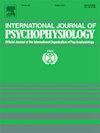睡眠质量静息状态fMRI脑网络属性的整体、中尺度和局部研究
IF 2.5
3区 心理学
Q3 NEUROSCIENCES
引用次数: 0
摘要
研究发现,睡眠质量差与人类大脑某些区域的功能异常有关。然而,大脑是一个动态的网络合作系统,有必要从多个层面研究睡眠质量与全脑网络活动的关系。共有115名大学生接受静息状态功能磁共振成像(rs-fMRI),并完成匹兹堡睡眠质量指数(PSQI)。将学生分为睡眠质量优良者(N = 65, PSQI<5)和睡眠质量差者(N = 50, PSQI≥5)。利用图论和机器学习方法对fMRI数据进行分析,比较不同层次功能网络拓扑结构的组间差异。整体分析表明,睡眠质量差组的小世界度较低,特征路径长度较高。中尺度分析表明,右侧额叶中回、双侧顶叶上回、双侧尾状核和右侧颞上回的亚网络功能是区分两组的重要指标。局部分析显示,两组患者左侧枕下回和左侧中央后回的节度差异有统计学意义。综上所述,这些发现加深了对睡眠质量与静息功能网络拓扑模式之间关系的宏观理解。本文章由计算机程序翻译,如有差异,请以英文原文为准。
Global, mesoscale and local investigation into resting state fMRI brain network attributes of sleep quality
Poor sleep quality has been found to be associated with functional abnormalities in a few regions of the human brain. However, the brain is a dynamic network cooperation system, and it is necessary to study the relationship between sleep quality and the whole-brain network activity at multiple levels. A total of 115 college students underwent resting-state fMRI (rs-fMRI) and completed the Pittsburgh Sleep Quality Index (PSQI). Students were divided into good-quality sleepers (N = 65, PSQI<5) and poor-quality sleepers (N = 50, PSQI≥5). The fMRI data were analyzed using graph theory and machine learning methods to compare between-group differences in functional network topology at different levels. Global analysis shows the poor sleep quality group had lower small-worldness and higher characteristic path length. The mesoscale analysis demonstrates the subnetwork functions of the right middle frontal gyrus, bilateral superior parietal gyrus, bilateral caudate nucleus, and right superior temporal gyrus are important indicators that distinguish between the two groups. Local analysis shows the nodal degree of the left inferior occipital gyrus and left postcentral gyrus significantly differed between the two groups. Taken together, these findings deepen the macroscopic understanding of the relationship between sleep quality and resting functional network topology patterns.
求助全文
通过发布文献求助,成功后即可免费获取论文全文。
去求助
来源期刊
CiteScore
5.40
自引率
10.00%
发文量
177
审稿时长
3-8 weeks
期刊介绍:
The International Journal of Psychophysiology is the official journal of the International Organization of Psychophysiology, and provides a respected forum for the publication of high quality original contributions on all aspects of psychophysiology. The journal is interdisciplinary and aims to integrate the neurosciences and behavioral sciences. Empirical, theoretical, and review articles are encouraged in the following areas:
• Cerebral psychophysiology: including functional brain mapping and neuroimaging with Event-Related Potentials (ERPs), Positron Emission Tomography (PET), Functional Magnetic Resonance Imaging (fMRI) and Electroencephalographic studies.
• Autonomic functions: including bilateral electrodermal activity, pupillometry and blood volume changes.
• Cardiovascular Psychophysiology:including studies of blood pressure, cardiac functioning and respiration.
• Somatic psychophysiology: including muscle activity, eye movements and eye blinks.

 求助内容:
求助内容: 应助结果提醒方式:
应助结果提醒方式:


